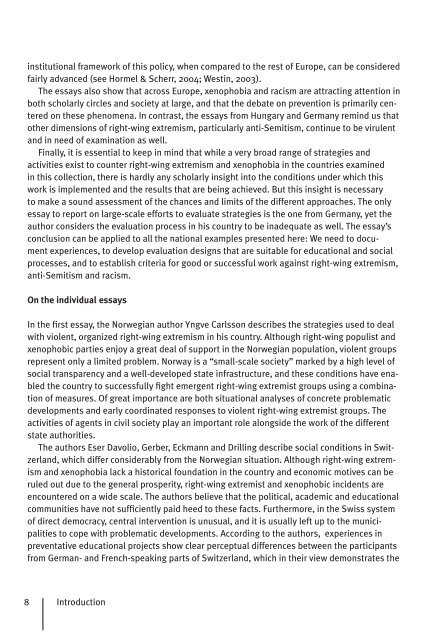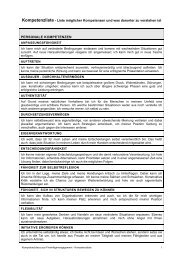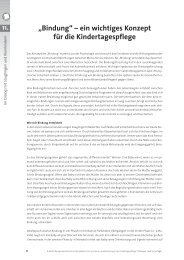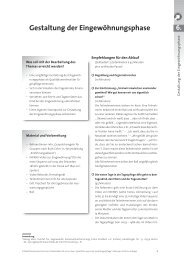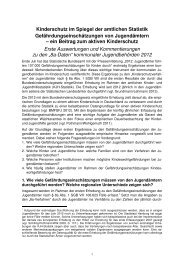Prevention of Right-Wing Extremism, Xenophobia and Racism in ...
Prevention of Right-Wing Extremism, Xenophobia and Racism in ...
Prevention of Right-Wing Extremism, Xenophobia and Racism in ...
You also want an ePaper? Increase the reach of your titles
YUMPU automatically turns print PDFs into web optimized ePapers that Google loves.
<strong>in</strong>stitutional framework <strong>of</strong> this policy, when compared to the rest <strong>of</strong> Europe, can be considered<br />
fairly advanced (see Hormel & Scherr, 2004; West<strong>in</strong>, 2003).<br />
The essays also show that across Europe, xenophobia <strong>and</strong> racism are attract<strong>in</strong>g attention <strong>in</strong><br />
both scholarly circles <strong>and</strong> society at large, <strong>and</strong> that the debate on prevention is primarily cen-<br />
tered on these phenomena. In contrast, the essays from Hungary <strong>and</strong> Germany rem<strong>in</strong>d us that<br />
other dimensions <strong>of</strong> right-w<strong>in</strong>g extremism, particularly anti-Semitism, cont<strong>in</strong>ue to be virulent<br />
<strong>and</strong> <strong>in</strong> need <strong>of</strong> exam<strong>in</strong>ation as well.<br />
F<strong>in</strong>ally, it is essential to keep <strong>in</strong> m<strong>in</strong>d that while a very broad range <strong>of</strong> strategies <strong>and</strong><br />
activities exist to counter right-w<strong>in</strong>g right-w<strong>in</strong>g extremism extremism <strong>and</strong> xenophobia <strong>in</strong> the countries exam<strong>in</strong>ed<br />
<strong>in</strong> this collection, there is hardly any scholarly <strong>in</strong>sight <strong>in</strong>to the conditions under which this<br />
work is implemented <strong>and</strong> the results that are be<strong>in</strong>g achieved. But this <strong>in</strong>sight is necessary<br />
to make a sound assessment assessment <strong>of</strong> the chances <strong>and</strong> limits <strong>of</strong> the different approaches. The only<br />
essay to report on large-scale efforts efforts to evaluate strategies is the one from Germany, yet the<br />
author considers the evaluation process <strong>in</strong> his country to be <strong>in</strong>adequate as well. The essay’s<br />
conclusion can be be applied to all the national examples presented here: We need to docu-<br />
ment experiences, to develop evaluation designs that are suitable for educational <strong>and</strong> social<br />
processes, <strong>and</strong> to establish criteria for good or successful work aga<strong>in</strong>st right-w<strong>in</strong>g extremism,<br />
anti-Semitism <strong>and</strong> racism.<br />
8<br />
On the <strong>in</strong>dividual essays<br />
In the fi rst essay, the Norwegian author Yngve Carlsson describes the strategies used to deal<br />
with violent, organized right-w<strong>in</strong>g extremism <strong>in</strong> his country. Although right-w<strong>in</strong>g populist <strong>and</strong><br />
xenophobic parties enjoy a great deal <strong>of</strong> support <strong>in</strong> the Norwegian population, violent groups<br />
represent only a limited problem. Norway is a “small-scale society” marked by a high level <strong>of</strong><br />
social transparency <strong>and</strong> a well-developed state <strong>in</strong>frastructure, <strong>and</strong> these conditions have enabled<br />
the country to successfully fi ght emergent right-w<strong>in</strong>g extremist groups us<strong>in</strong>g a comb<strong>in</strong>a-<br />
tion <strong>of</strong> measures. Of great importance are both situational analyses <strong>of</strong> concrete problematic<br />
developments <strong>and</strong> early coord<strong>in</strong>ated responses to violent right-w<strong>in</strong>g extremist groups. The<br />
activities <strong>of</strong> agents <strong>in</strong> civil society play an important role alongside the work <strong>of</strong> the different<br />
state authorities.<br />
The authors Eser Davolio, Gerber, Eckmann <strong>and</strong> Drill<strong>in</strong>g describe social conditions <strong>in</strong> SwitSwitzerl<strong>and</strong>, which which differ considerably considerably from the Norwegian situation. Although right-w<strong>in</strong>g extrem-<br />
ism <strong>and</strong> xenophobia lack a historical foundation <strong>in</strong> the country <strong>and</strong> economic motives can be<br />
ruled out due to the general prosperity, right-w<strong>in</strong>g extremist <strong>and</strong> xenophobic <strong>in</strong>cidents are<br />
encountered on a wide scale. The authors believe that the political, academic <strong>and</strong> educational<br />
communities have not suffi ciently paid heed to these facts. Furthermore, <strong>in</strong> the Swiss system<br />
<strong>of</strong> direct democracy, central <strong>in</strong>tervention is unusual, <strong>and</strong> it is usually left up to the munici-<br />
palities to cope with problematic developments. Accord<strong>in</strong>g to the authors, experiences <strong>in</strong><br />
preventative educational projects show clear perceptual differences between the participants<br />
from German- <strong>and</strong> French-speak<strong>in</strong>g parts <strong>of</strong> Switzerl<strong>and</strong>, which <strong>in</strong> their view demonstrates the<br />
Introduction


